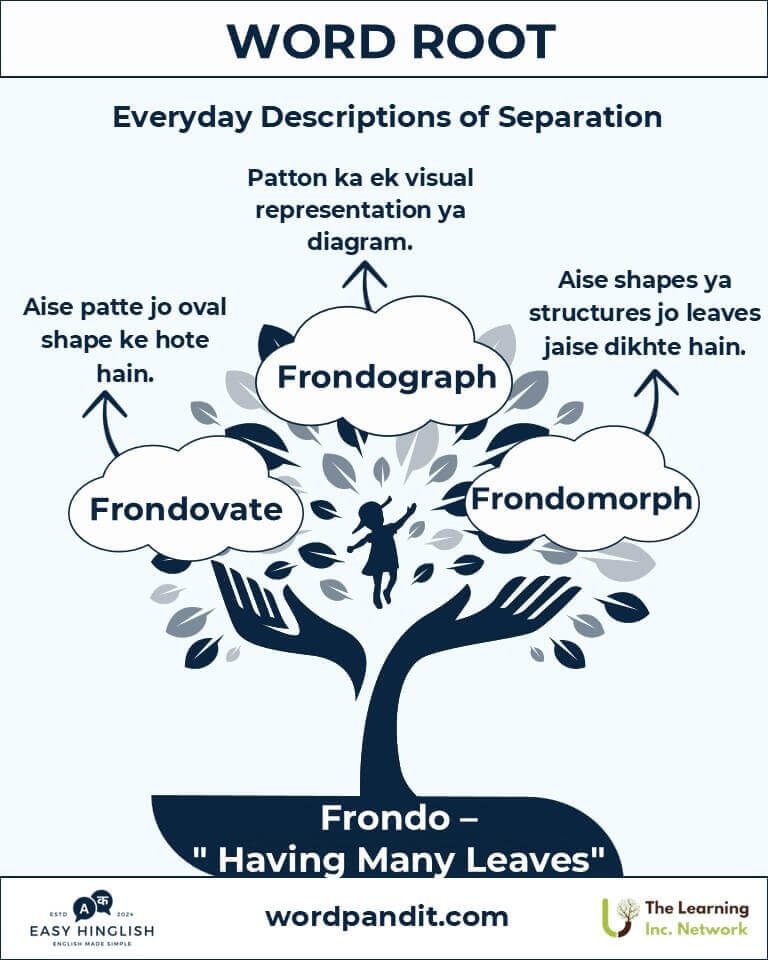Frondo: The Root of Leafiness in Nature and Language
(Frondo: Prakriti aur Bhasha ka Pata Se Jude Mool - फ्रॉन्डो: प्रकृति और भाषा का पत्ता से जुड़े मूल)
Dive into the lush and leafy world of the root "Frondo," derived from Latin, meaning "leaf." From the verdant forests symbolized by "frondose" to the poetic emergence of "frondescence," this root celebrates the beauty and vitality of foliage in both nature and language.

Table of Contents
- Introduction: The Green Essence of "Frondo"
- Etymology and Historical Journey
- Mnemonic: Unlocking the Power of "Frondo"
- Common "Frondo"-Related Terms
- "Frondo" Through Time
- "Frondo" in Specialized Fields
- Illustrative Story: "Frondo" in Action
- Cultural Significance of the "Frondo" Root
- The "Frondo" Family Tree
- FAQs About the "Frondo" Word Root
- Test Your Knowledge: "Frondo" Mastery Quiz
- Conclusion: The Flourishing Legacy of "Frondo"
1. Introduction: The Green Essence of "Frondo"
(Frondo ka Mool Arth - फ्रॉन्डो का मूल अर्थ)
Imagine a dense jungle, jahan har taraf lush greenery ho aur har frond (पत्ती) hawa mein hil rahi ho. "Frondo" root ka essence isi greenery aur vitality ko capture karta hai.
Latin word "frons," jiska matlab "leaf" (पत्ता) ya "foliage" (हरियाली) hota hai, se derived, "Frondo" ke kayi shabdon ne botany, poetry, aur artistic expressions mein apni jagah banayi hai.

2. Etymology and Historical Journey
(Frondo ki Utpatti aur Itihaas - फ्रॉन्डो की उत्पत्ति और इतिहास)
Latin word "frons" sirf patti ka physical structure nahi, balki honor aur renewal ke symbol ke roop mein bhi use hota tha, jaise laurel crowns.
Medieval Europe ke time pe, "frondo" se derived shabd jaise "frondose" (leafy) aur "frondescence" (process of leafing) English aur French mein aaye. Yeh words abundance aur growth (समृद्धि और विकास) ko symbolize karte hain.
3. Mnemonic: Unlocking the Power of "Frondo"
(Mnemonic ke Zariye Frondo ko Yaad Rakhein - फ्रॉन्डो को याद रखने की तरकीब)
Imagine kariye ek tree jo har spring season mein naye patton se bhar jata hai. Is vivid imagery ke saath, Frondo ka matlab yaad rakhna asaan ho jata hai.
Mnemonic Device: "Frondo—jahaan nature apni leafy beauty dikhata hai."
4. Common "Frondo"-Related Terms
(Frondo Words aur Unka Arth - फ्रॉन्डो के शब्द और उनके अर्थ)
- Frondose: Having many leaves or leafy structures (ज़्यादा पत्तों वाला).
Example: "Frondose canopy ne summer ke dinon mein shade provide kiya." - Frondescence: The process or period of unfolding leaves (पत्तों के खिलने की प्रक्रिया).
Example: "Springtime frondescence park ko ek paradise mein badal deta hai." - Frondlet: A small or delicate frond (एक छोटी और कोमल पत्ती).
Example: "Ferns ke frondlets hawa mein gently wave kar rahe the." - Defronde: To strip of leaves (पत्तों को हटाना).
Example: "Caterpillars ne plants ko defronde karke bas bare stems chhod diye."
5. "Frondo" Through Time
(Samay ke Saath Frondo ka Safar - समय के साथ फ्रॉन्डो का सफर)
- Medieval Botany: "Frondose" plants ko describe karta tha jo leafy the.
- Modern Literature: "Frondescence" vivid imagery create karta hai, jo seasonal rebirth ko signify karta hai.
6. "Frondo" in Specialized Fields
(Vishesh Kshetron mein Frondo ka Upyog - विशिष्ट क्षेत्रों में फ्रॉन्डो का उपयोग)
- Botany: Frondose plants aur species ko classify karne mein use hota hai.
- Art and Literature: Frondescence imagery ka use renewal symbolize karne ke liye hota hai.
- Environmental Science: Defronde leaf loss process ko describe karta hai.
7. Illustrative Story: "Frondo" in Action
(Frondo ki Ek Kahani - फ्रॉन्डो की प्रेरणादायक कहानी)
Ek island par biologist Clara seasonal frondescence ko study kar rahi thi. Ek storm ke baad, plants defronde ho gaye, lekin kuch hi dinon mein naye frondlets grow hone lage. Clara ke is observation ne ek children's book "The Tale of Frondy" ko inspire kiya, jo resilience aur nature ke renewal ke baare mein hai.
8. Cultural Significance of the "Frondo" Root
(Frondo ka Sanskritik Mahatva - फ्रॉन्डो का सांस्कृतिक महत्व)
Har culture mein leaves (पत्ते) growth, hope aur life cycles ko symbolize karte hain. Romans ne laurel leaves ko honor ke roop mein use kiya, aur frondose imagery fertility aur prosperity (उर्वरता और समृद्धि) ko dikhata hai.

9. The "Frondo" Family Tree
(Frondo Family ke Related Words - फ्रॉन्डो परिवार के संबंधित शब्द)
- Foli- (Latin: "leaf")
Example: Foliage (पत्तों का समूह). - Lign- (Latin: "wood")
Example: Lignify (लकड़ी में बदलना). - Verd- (Latin: "green")
Example: Verdant (हरियाली से भरा हुआ).

FAQs About the "Frondo" Word Root
Q: "Frondo" ka kya matlab hai?
A: "Frondo" Latin word "frons" se aaya hai, jiska matlab hai "leaf" (पत्ता) ya "foliage" (हरियाली). Yeh leafy structures aur growth se jude processes ko describe karta hai.
Q: "Frondescence" ka kya arth hai?
A: "Frondescence" ka matlab hai wo process ya period jisme plants naye patte develop karte hain ya unfold hote hain. Iska use botany aur poetry dono mein hota hai.
Q: "Frondo" ka sabse zyada use kahan hota hai?
A: "Frondo" ka primary use botany mein hota hai jaha leafy characteristics aur growth processes ko describe karne ke liye isse use kiya jata hai. Literature aur art mein bhi iska symbolic use hota hai.
Q: "Defronde" ka kya matlab hota hai?
A: "Defronde" ka matlab hai kisi plant ke leaves ko hata dena ya unhe strip karna. Yeh term natural processes (jaise pests ya storms) aur human intervention dono ke liye use hota hai.
Q: Botany mein "Frondose" ka kya significance hai?
A: Botany mein "Frondose" leafy plants ya fronds ki abundance ko describe karta hai. Yeh term dense plant growth aur leafy structures ko classify karne mein help karta hai.
Test Your Knowledge: Frondo Mastery Quiz
1. "Frondo" ka matlab kya hai?
2. "Frondescence" ka arth kya hai?
3. Kaunsa term plant ke leaves strip karne ko describe karta hai?
4. "Frondose" ka kya arth hai?
5. Ek chhoti frond ko kya kehte hain?
12. Conclusion: The Flourishing Legacy of "Frondo"
(Frondo ki Jeevant Virasat - फ्रॉन्डो की जीवंत विरासत)
"Frondo" root language mein life aur beauty ka ek symbol hai. Iske derivatives jaise "frondescence" aur "frondose" nature ki lushness aur cyclical growth ko highlight karte hain.








